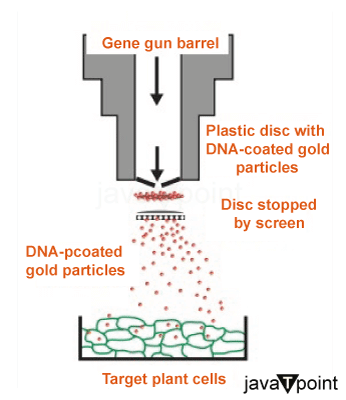Gene Gun MethodWhat is Gene Transfer?The process by which genetic material is transferred between other organisms is referred to as gene transfer. It is essential to several industries, including biotechnology, genetics, and medicine. Gene transfer can happen in bacteria naturally through a process called horizontal gene transfer, or it can happen unnaturally through methods like genetic engineering. In nature, the spread of advantageous features among many species is caused by gene transfer. Horizontal gene transfer enables bacteria to acquire genes for antibiotic resistance, resulting in the emergence of superbugs that provide serious problems for the healthcare industry. Similar to this, gene transfer can take place between different kingdoms of life, including plants, animals, and even between them, allowing favourable traits to spread and promoting evolution. Gene transfer has transformed the creation of important compounds in the realm of biotechnology. Scientists can increase the capacity of microbes or plants to produce drugs, enzymes, or biofuels by inserting particular genes into them. Recombinant DNA technology, a method used to create genetically modified organisms (GMOs) with enhanced traits, has paved the path for their development. Additionally, gene transfer has created new opportunities for the practise of medicine. Gene therapy involves inserting functioning genes into sick cells in an effort to treat or prevent disease. This strategy has a lot of potential for treating cancer, hereditary disorders, and other genetic illnesses. Researchers are investigating a variety of gene delivery techniques, including viral and non-viral vectors as well as genome editing tools like CRISPR-Cas9. What is Gene Gun Method of Gene Transfer?Direct gene transfer into cells is accomplished via the gene cannon technique, sometimes referred to as biolistic or particle bombardment. The gene gun uses physical force to inject genetic material into target cells, as opposed to other techniques of gene transfer that rely on biological vectors like viruses. This technique is useful for genetic research, biotechnology, and gene therapy because it has been shown to be successful in a variety of organisms, including plants and mammals. 
The gene gun method uses a tool called a gene gun, also known as a biolistic particle delivery system. The genetic material for the gene gun is placed onto minuscule objects like gold or tungsten beads in a small chamber. For the purpose of gene transfer, these particles act as bullets or carriers. Usually, the target cells are positioned on a flat surface, like a culture plate or petri dish. The particle-coated with the appropriate genetic material gene gun apparatus is positioned above the cells, and a burst of high-pressure helium or nitrogen gas is utilised to drive the particles towards the cells. The genetic material enters the cells after the particles break through the cell membranes. Depending on the experimental setup and the type of genetic material being transferred, the genetic material can either integrate into the host genome or remain as extrachromosomal DNA once inside the cells. The implanted genes can then be expressed as the cells continue to grow and divide, bringing about the desired phenotypic changes or the creation of particular proteins. The gene gun technique has been used extensively in a variety of fields. In plant biotechnology, it has been widely employed to produce genetically engineered crops with desirable features, such as increased disease resistance or greater nutritional value. In order to create transgenic animals and study gene function as well as in studies of gene therapy for prospective treatments of genetic illnesses in humans, the approach has also been used in animal research. Mechanism of Gene Gun Method TransferStep 1: The selection of the donor DNA is the initial stage in the gene gun procedure. The desired gene is present in the donor DNA and must be introduced into the plant cells. The gene can be acquired from a variety of sources, including bacteria, other plants, or synthetic constructs. Once the desired gene has been located and isolated, it is often amplified using PCR to produce an amount large enough for the transfer procedure. 
Step 2: Plant tissue is now ready for gene transfer in this step. For this reason, young, actively growing plant tissues like leaf or shoot explants are typically used. To eliminate any pollutants that can obstruct the gene-transfer process, the plant tissue is meticulously removed and sterilised. Typically, plant tissue is sterilised by being exposed to a solution of ethanol and bleach. Step 3: After the donor DNA has been dissolved in an appropriate buffer, the gene gum solution is created. During the transfer procedure, the buffer aids in preserving the stability and integrity of the DNA. In order to ensure the best possible efficiency of gene transfer, the gene gum solution is normally produced at a specified concentration. To avoid deterioration or contamination, the DNA and gene gum solution must be handled carefully. Step 4: In this phase, the produced plant tissue is incubated in the gene gum solution. Incubation of Plant Tissue in Gene Gum Solution. The DNA can interact with the plant cells since the plant tissue is submerged in the fluid. Depending on the plant type and the intended gene transfer efficiency, the incubation period may differ. The plant cells are penetrated by the gene gum solution in this stage, aiding in the transfer of the donor DNA. Step 5: Agrobacterium is a common bacterium that is employed as a vector in gene transfer techniques. Co-cultivation of plant tissue with Agrobacterium. In this step, a particular strain of Agrobacterium is co-cultivated with the incubated plant tissue in order to produce the desired gene. The donor DNA from the gene gum solution can be transferred from the Agrobacterium to the plant cells by co-cultivating the plant tissue and the Agrobacterium in an appropriate growth medium. Step 6: After co-cultivation, the plant tissue is put through a screening process to determine which cells successfully underwent a transformation and to separate those cells. This selection is accomplished by adding a selective chemical to the growing medium, such as an antibiotic or a herbicide. In the presence of the selection agent, only the transformed cells that have effectively incorporated the donor DNA and expressed the selectable marker gene will endure and proliferate. Step 7: The chosen transgenic cells are then stimulated in a growth medium enriched with plant hormones to develop shoots. This process promotes the growth of many shoots from the altered cells. When shoots have developed, they can be planted in a rooting media to encourage the development of roots. Plants that have been rooted are then moved to soil or a greenhouse for additional growth and development. Step 8: It's crucial to verify the presence and stability of the transplanted gene after transgenic plants have successfully regenerated. The genomic DNA of transgenic plants is examined using molecular methods like PCR and DNA sequencing. These methods enable scientists to confirm the donor DNA's incorporation into the plant genome and guarantee its stability over generations. Scientists can verify the effective transfer of the targeted gene by comparing the DNA sequences of the transgenic plants with the original donor DNA. Step 9: The transgenic plants are then subjected to phenotypic examination to evaluate the expression and functionality of the transplanted gene after molecular characterisation is complete. In this examination, the physical qualities and attributes of the transgenic plants are examined, and they are contrasted with non-transgenic plants or control groups. It aids in determining whether the transplanted gene has produced the intended phenotypic modifications, such as improved pest resistance or increased yield. Step 10: Following a satisfactory phenotypic study, transgenic plants are tested in the field and evaluated to see how well they perform there. Large-scale field trials are conducted using transgenic plants to assess their agronomic characteristics, yield potential, and environmental effects. This process makes that the transgenic plants have desirable features and can be safely and successfully included into farming methods. Step 11: Transgenic plants must receive regulatory approval to verify their safety for consumption by humans and the environment before being made available for commercial use. Regulatory organisations analyse the information from lab experiments, field tests, and environmental impact assessments in order to identify the potential risks connected to transgenic plants. The transgenic plants can be allowed for commercial production and use once the legal conditions have been satisfied. Step 12: The transgenic plants can be deployed for agricultural use and sold once they have received regulatory permission. Farmers may receive the transgenic seeds from seed corporations, who may then grow the transgenic plants on their fields. It is possible that the commercialization and use of transgenic plants will have positive effects on crop yield, disease and insect resistance, and the need for chemical inputs. Advantages and Disadvantages of the Gene Gun MethodAdvantages
Disadvantages
Uses of Gene Gun MethodSome areas where the gene gun method is commonly used: Plant Genetic Engineering: By facilitating the transport of genes into plant cells, the gene gun technique has revolutionised plant genetic engineering. Crops have benefited from the introduction of desirable features like greater disease resistance, increased yield, and improved nutritional value. Plants with hard cell walls, which are challenging to alter using conventional procedures, benefit greatly from the method. Vaccine Development: DNA vaccines have been created using the gene gun technique. The gene gun is capable of inducing an immunological response and the generation of defense-enhancing antibodies by delivering genes encoding certain antigens directly into host cells. This strategy has showed promise in the development of vaccines against a number of illnesses, including cancer and viral infections. Animal Transgenesis: Foreign genes have been inserted into animal embryos or cells using the gene gun technique. The development of transgenic animals for research purposes, such as the investigation of gene function or the manufacturing of biopharmaceuticals, has been made easier thanks to this approach. Animal husbandry has also used it to create animals with better qualities, such disease resistance or faster growth. Gene Therapy: For the purpose of delivering therapeutic genes into human cells for gene therapy, the gene gun technique has been investigated as a promising tool. It tries to treat genetic illnesses or other diseases brought on by gene abnormalities by directly introducing functioning genes into target tissues. The gene gun technology offers a non-viral option for gene delivery with potential clinical uses, even though gene therapy is still in its infancy. Basic Research: In order to investigate gene function, regulatory components, and protein expression, the gene gun method is frequently employed in basic research. Genetic material can be altered, and the repercussions can be seen in different animals and cell types. Our comprehension of basic biological processes has improved as a result of this technique.
Next TopicOverlapping Genes
|
 For Videos Join Our Youtube Channel: Join Now
For Videos Join Our Youtube Channel: Join Now
Feedback
- Send your Feedback to [email protected]
Help Others, Please Share









